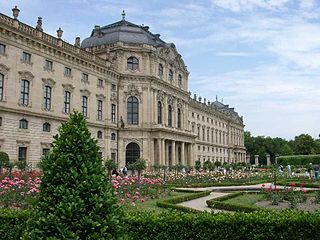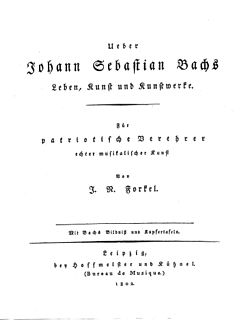Execution
The ornament is a trill on a long-short dotted rhythm accelerating to end on either a tremolo or a regular trill. [1]

![]() Play (help·info)
Play (help·info)
Ribattuta or Ribattuta di gola is a musical ornament found in Italian and German works of the 17th and 18th centuries.
The ornament is a trill on a long-short dotted rhythm accelerating to end on either a tremolo or a regular trill. [1]

![]() Play (help·info)
Play (help·info)
The ornament is described by Mattheson (1739), [2] Spiess (1745), [3] and Marpurg (1749). [4]
Frederick Neumann [5] notes the trill following the dotted preparation is a main-note trill (that is, starting on the written note), and he cautions against use of the term as a general descriptor for dotted alternation as a prelude to a trill.
Italian: ribattuta (f) di gola
German: der Zurückschlag [6] or der gedehnte oder punctirte Triller (Mattheson)
English: ribattuta
French: ribattuta (f) or tour de gosier (Marpurg) or cadence pleine à progression (Lacassagne) [7] or double cadence (Bérard-Blanchet) [8]

Rococo, less commonly Roccoco or Late Baroque, is an exceptionally ornamental and theatrical style of architecture, art and decoration which combines asymmetry, scrolling curves, gilding, white and pastel colours, sculpted moulding, and trompe-l'œil frescoes to create surprise and the illusion of motion and drama. It is often described as the final expression of the Baroque movement.
In music, ornaments or embellishments are musical flourishes—typically, added notes—that are not essential to carry the overall line of the melody, but serve instead to decorate or "ornament" that line, provide added interest and variety, and give the performer the opportunity to add expressiveness to a song or piece. Many ornaments are performed as "fast notes" around a central, main note.
The trill is a musical ornament consisting of a rapid alternation between two adjacent notes, usually a semitone or tone apart, which can be identified with the context of the trill. It is sometimes referred to by the German Triller, the Italian trillo, the French trille or the Spanish trino. A cadential trill is a trill associated with each cadence. A trill provides rhythmic interest, melodic interest, and—through dissonance—harmonic interest. Sometimes it is expected that the trill will end with a turn, or some other variation. Such variations are often marked with a few appoggiaturas following the note bearing the trill indication.
In Western musical theory, a cadence is the end of a phrase in which the melody or harmony creates a sense of resolution. A harmonic cadence is a progression of two or more chords that concludes a phrase, section, or piece of music. A rhythmic cadence is a characteristic rhythmic pattern that indicates the end of a phrase. A cadence is labeled like or less "weak" or "strong" depending on the impression of finality it gives. While cadences are usually classified by specific chord or melodic progressions, the use of such progressions does not necessarily constitute a cadence—there must be a sense of closure, as at the end of a phrase. Harmonic rhythm plays an important part in determining where a cadence occurs.

Georg Christoph Wagenseil was an Austrian composer.

Johann Balthasar Neumann, usually known as Balthasar Neumann, was a German architect and military artillery engineer who developed a refined brand of Baroque architecture, fusing Austrian, Bohemian, Italian, and French elements to design some of the most impressive buildings of the period, including the Würzburg Residence and the Basilica of the Fourteen Holy Helpers.

Coloratura is an elaborate melody with runs, trills, wide leaps, or similar virtuoso-like material, or a passage of such music. Operatic roles in which such music plays a prominent part, and singers of these roles, are also called coloratura. Its instrumental equivalent is ornamentation.

The Würzburg Residence is a palace in Würzburg, Germany. Johann Lukas von Hildebrandt and Maximilian von Welsch, representatives of the Austrian/South German Baroque style, were involved in the construction, as well as Robert de Cotte and Germain Boffrand, who were followers of the French Style. Balthasar Neumann, court architect of the Bishop of Würzburg, was the principal architect of the Residence, which was commissioned by the Prince-Bishop of Würzburg Johann Philipp Franz von Schönborn and his brother Friedrich Carl von Schönborn in 1720, and completed in 1744. The Venetian painter Giovanni Battista Tiepolo, assisted by his son, Domenico, painted frescoes in the building.
The doctrine of the affections, also known as the doctrine of affects, doctrine of the passions, theory of the affects, or by the German term Affektenlehre was a theory in the aesthetics of painting, music, and theatre, widely used in the Baroque era (1600–1750). Literary theorists of that age, by contrast, rarely discussed the details of what was called "pathetic composition", taking it for granted that a poet should be required to "wake the soul by tender strokes of art". The doctrine was derived from ancient theories of rhetoric and oratory. Some pieces or movements of music express one Affekt throughout; however, a skillful composer like Johann Sebastian Bach could express different affects within a movement.

Johannes (Johann) Zick was a German painter of frescoes in southern Germany and active during the Baroque period. He was the father of painter Januarius Zick and considered to be an important master of the Late Baroque.

Bernardo Antonio Vittone was an Italian architect and writer. He was one of the three most important Baroque architects active in the Piedmont region of Northern Italy; the other two were Filippo Juvarra and Guarino Guarini. The youngest of the three, Vittone was the only one who was born in Piedmont. He achieved a synthesis of the spatial inventiveness of Juvarra and the engineering ingenuity of Guarini, particularly in the design of his churches, the buildings for which he is best known.
Johann Gottlieb Janitsch was a German Baroque composer who wrote in the galant style, transitional between the Baroque and Classical periods.

Lorenz Christoph Mizler von Kolof was a German physician, historian, printer, mathematician, Baroque music composer, and precursor of the Enlightenment in Poland.

Brandenburg-Schwedt was a secundogeniture of the Hohenzollern margraves of Brandenburg, established by Prince Philip William who took his residence at Schwedt Castle in 1689. By appanage, they administered the manors of Schwedt and Vierraden on the Oder river as well as Wildenbruch in Pomerania. Though prosperous, the cadet branch never obtained Imperial immediacy.

The slide is a musical ornament often found in baroque musical works, but used during many different periods. It instructs the performer to begin two or three scale steps below the marked note and "slide" upward—that is, move stepwise diatonically between the initial and final notes. Though less frequently found, the slide can also be performed in a descending fashion.
Giovanni Luca Conforti was an Italian composer and prominent falsetto singer who wrote an exercise book about Baroque embellishments, Breve et facile maniera d'essercitarsi ad ogni scolaro or Brief and easy manner of exercising for every student, still in use today.
Christoph Nichelmann was a German composer and harpsichordist. He was second keyboard player in the Royal Ensemble of Frederick the Great.

The first major biographies of Johann Sebastian Bach, including those by Johann Nikolaus Forkel and Philipp Spitta, were published in the 19th century. Many more were published in the 20th century by, among others, Albert Schweitzer, Charles Sanford Terry, Christoph Wolff and Klaus Eidam.